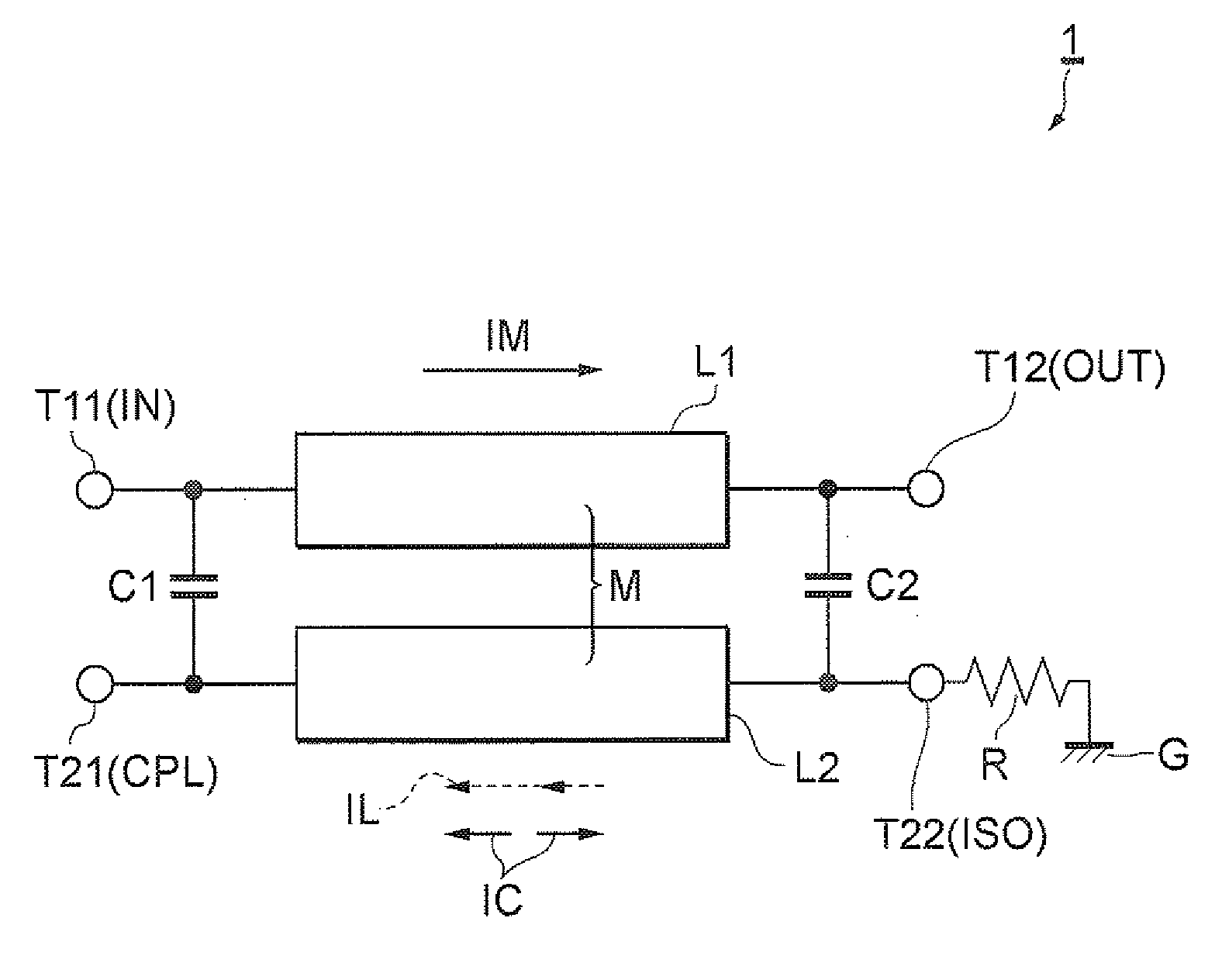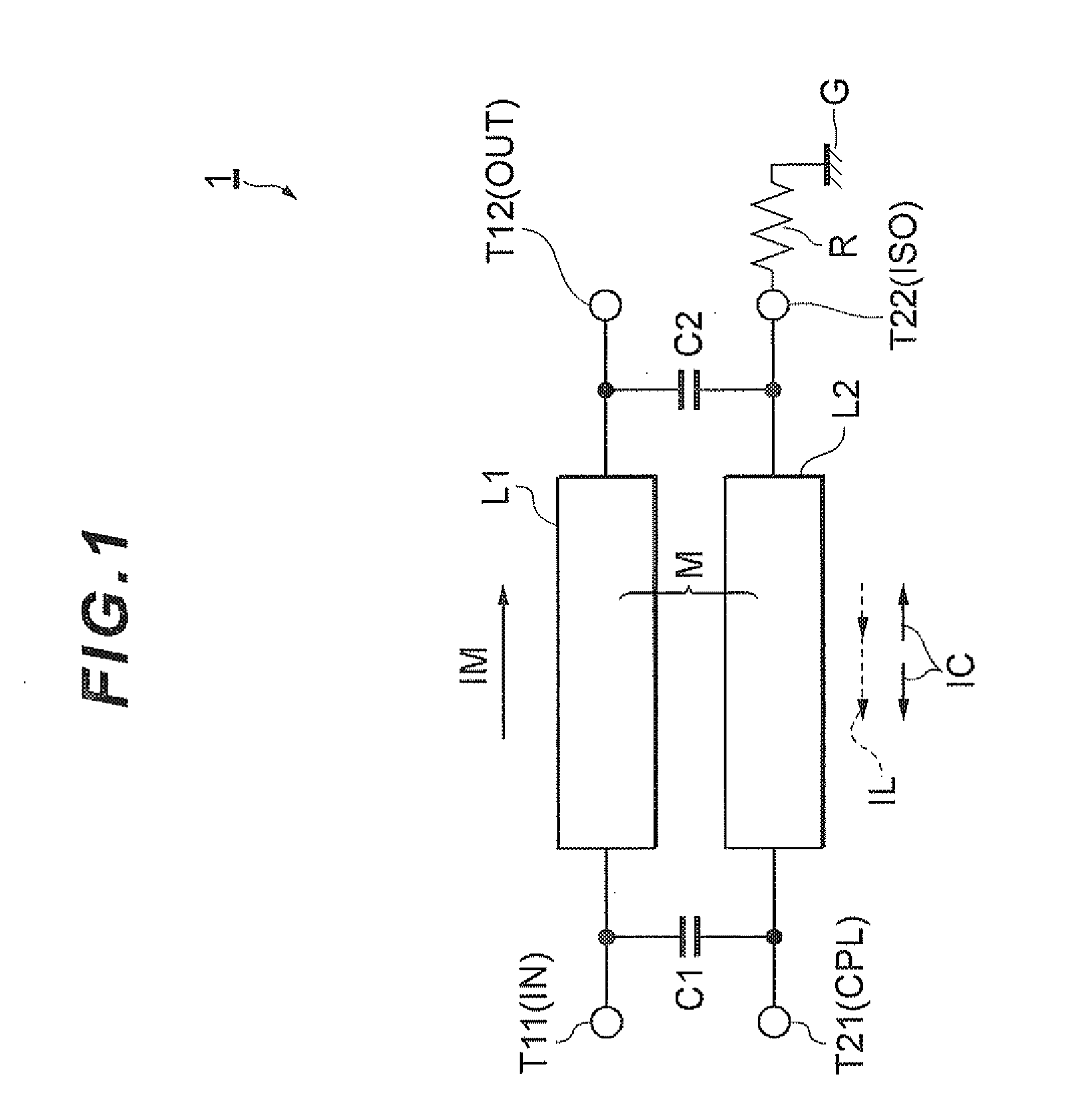Coupler
- Summary
- Abstract
- Description
- Claims
- Application Information
AI Technical Summary
Benefits of technology
Problems solved by technology
Method used
Image
Examples
embodiment 1
[0066]Next, one example of the respective patterns of the wiring layers M1, M2 and M3 in a coupler of Embodiment 1 will be described in detail. In the below embodiment, coils are used for the main line and the secondary line which constitute the lines L1 and L2 respectively.
[0067]FIGS. 3-8 are horizontal sectional views schematically illustrating the respective layers M1-M3 and I1-I3 of the coupler 1. As illustrated in FIGS. 3-8, the input terminal T11, the output terminal T12, the coupling terminal T21, and the isolation terminal T22 are formed in all the wiring layers M1-M3, and the portions of the terminals T11, T12, T21 and T22 formed in one layer are electrically connected to the corresponding portions in a different layer. The following is a detailed explanation of the configuration of each layer.
[0068]Referring to FIG. 3, in the wiring layer M1 formed on the insulating substrate 100 (via the insulating film 101), the coiled first line L1 is formed. In the wiring layer M1, the...
embodiment 1a
[0085]Next, the respective patterns of the wiring layers M1, M2 and M3 in a coupler according to Embodiment 1A will be described in detail. FIGS. 11-16 are horizontal sectional views schematically illustrating the respective layers M1-M3 and I1-I3 of a coupler 1A. As illustrated in FIGS. 11-16, the input terminal T11, the output terminal T12, the coupling terminal T21, and the isolation terminal T22 are formed in all the wiring layers M1-M3, and the portions of the terminals T11, T12, T21 and T22 formed in one layer are electrically connected to the corresponding portions in a different layer. The following is a detailed explanation of the configuration of each layer.
[0086]Referring to FIG. 11, in the wiring layer M1 formed on the insulating substrate 100 (via the insulating film 101), the coiled first line L1 is formed. In the wiring layer M1, the outer end of the coiled first line L1 is connected to the output terminal T12, and the inner end of the first line L1 is connected to th...
embodiment 1b
[0097]Next, the configuration of a coupler according to Embodiment 1B will be described. FIGS. 18-22 are horizontal sectional views schematically illustrating the respective layers M1-M3 and I1-I2 of a coupler 1B. The pattern of the passivation layer I3 of Embodiment 1B is the same as that of Embodiment 1A. Also, as with Embodiment 1, the terminals T11,T12,T21 and T22 are formed in all the wiring layers M1-M3. Referring to FIG. 18, in the wiring layer M1 formed on the insulating substrate 100 (via the insulating film 101), the coiled first line L1 is formed. In Embodiment 1B, the first line L1 formed in the wiring layer M1 has a different number of windings from that of Embodiment 1A, and the position of the inner end also differs from Embodiment 1A. Accordingly, the via P11 of Embodiment 1A, which is connected to the inner end of the first line L1, is arranged in an area close to the isolation terminal T22 (see FIG. 11); whereas, the via P11 of Embodiment 1B, which is connected to ...
PUM
 Login to View More
Login to View More Abstract
Description
Claims
Application Information
 Login to View More
Login to View More - R&D
- Intellectual Property
- Life Sciences
- Materials
- Tech Scout
- Unparalleled Data Quality
- Higher Quality Content
- 60% Fewer Hallucinations
Browse by: Latest US Patents, China's latest patents, Technical Efficacy Thesaurus, Application Domain, Technology Topic, Popular Technical Reports.
© 2025 PatSnap. All rights reserved.Legal|Privacy policy|Modern Slavery Act Transparency Statement|Sitemap|About US| Contact US: help@patsnap.com



